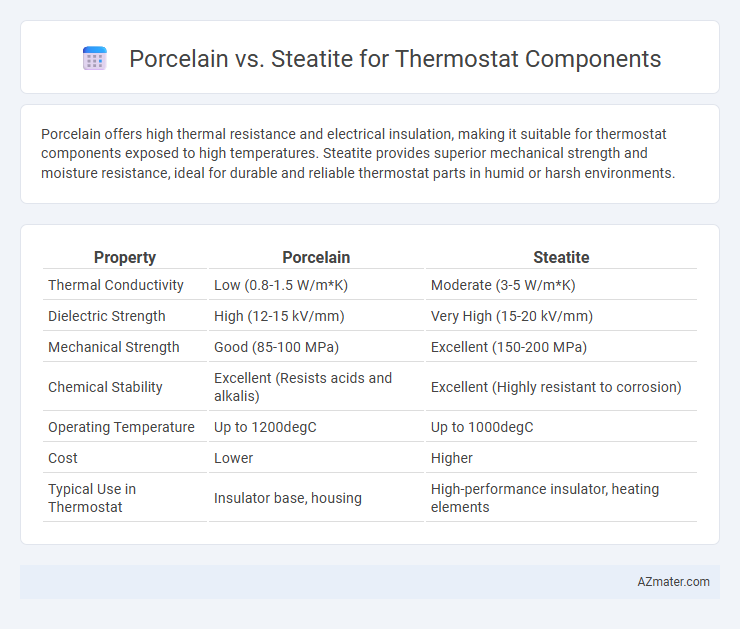Porcelain offers high thermal resistance and electrical insulation, making it suitable for thermostat components exposed to high temperatures. Steatite provides superior mechanical strength and moisture resistance, ideal for durable and reliable thermostat parts in humid or harsh environments.
Table of Comparison
| Property | Porcelain | Steatite |
|---|---|---|
| Thermal Conductivity | Low (0.8-1.5 W/m*K) | Moderate (3-5 W/m*K) |
| Dielectric Strength | High (12-15 kV/mm) | Very High (15-20 kV/mm) |
| Mechanical Strength | Good (85-100 MPa) | Excellent (150-200 MPa) |
| Chemical Stability | Excellent (Resists acids and alkalis) | Excellent (Highly resistant to corrosion) |
| Operating Temperature | Up to 1200degC | Up to 1000degC |
| Cost | Lower | Higher |
| Typical Use in Thermostat | Insulator base, housing | High-performance insulator, heating elements |
Introduction to Thermostat Component Materials
Porcelain and steatite are commonly used materials for thermostat components, valued for their excellent thermal insulation and electrical resistance properties. Porcelain offers high mechanical strength and durability at elevated temperatures, making it suitable for environments with frequent thermal cycling. Steatite, composed mainly of magnesium silicate, provides superior electrical insulation and resistance to thermal shock, often preferred in high-voltage or high-temperature applications.
Overview of Porcelain in Thermostat Applications
Porcelain is widely used in thermostat components due to its excellent electrical insulation properties and high thermal resistance, making it ideal for environments exposed to heat and electrical stress. Its durability and ability to withstand temperature fluctuations ensure reliable performance in controlling heating or cooling systems. The material's hardness also contributes to the long lifespan and stability of thermostatic devices in both residential and industrial applications.
Steatite: Properties and Uses in Thermostats
Steatite, a dense ceramic composed primarily of magnesium silicate, offers excellent electrical insulation and high thermal shock resistance, making it ideal for thermostat components. Its low thermal conductivity ensures stable temperature control and durability under repeated heating cycles. Commonly used for insulating bases and structural parts in thermostats, steatite enhances safety and reliability in temperature regulation devices.
Electrical Insulation Capabilities: Porcelain vs Steatite
Porcelain and steatite are both widely used as electrical insulators in thermostat components, but their insulation capabilities differ significantly. Porcelain offers excellent electrical insulation with high dielectric strength and resistance to thermal shock, making it ideal for high-voltage applications. Steatite provides superior mechanical strength and moisture resistance while maintaining good dielectric properties, favoring environments where durability and insulation reliability are critical under varying temperature and humidity conditions.
Thermal Stability and Heat Resistance Comparison
Porcelain exhibits superior thermal stability withstanding temperatures up to 1200degC, making it highly resistant to thermal shock and maintaining structural integrity under rapid temperature fluctuations. Steatite offers good heat resistance, typically tolerating temperatures up to 1000degC, but it is more prone to deformation under prolonged high heat exposure compared to porcelain. The enhanced thermal stability of porcelain ensures better durability and performance in high-temperature thermostat components, while steatite remains a cost-effective option for moderate heat applications.
Mechanical Strength and Durability Analysis
Porcelain exhibits superior mechanical strength with high compressive resistance and excellent thermal shock tolerance, making it ideal for thermostat components exposed to fluctuating temperatures. Steatite offers reliable durability with good wear resistance and electrical insulation but generally shows lower mechanical strength compared to porcelain under mechanical stress. For thermostat applications requiring long-term structural integrity under mechanical load, porcelain remains the preferred choice due to its enhanced toughness and longevity.
Cost and Availability Considerations
Porcelain thermostat components generally have higher costs due to raw material expenses and specialized manufacturing processes, whereas steatite offers a more cost-effective alternative with easier sourcing of raw materials. Steatite's widespread availability in industrial supply chains ensures faster procurement and lower lead times compared to porcelain, which can face production bottlenecks in limited specialty suppliers. Cost-efficiency and consistent accessibility make steatite a preferred choice for large-scale thermostat component manufacturing where budget constraints and timely delivery are critical.
Manufacturing and Machinability Differences
Porcelain offers excellent thermal resistance and electrical insulation but is brittle and challenging to machine, requiring precise molding and firing processes that increase manufacturing complexity. Steatite, a machinable ceramic primarily composed of talc, exhibits superior machinability with the ability to be shaped using conventional cutting tools, leading to more cost-effective and flexible manufacturing. The choice between porcelain and steatite components hinges on balancing porcelain's superior insulation properties against steatite's ease of machining and lower production costs.
Long-Term Performance and Reliability
Steatite exhibits superior long-term performance and reliability in thermostat components due to its excellent thermal shock resistance and stable dielectric properties under high temperature cycles. Porcelain, while offering good mechanical strength, tends to degrade faster in harsh thermal environments because of its lower fracture toughness and susceptibility to microcracking. The consistent dimensional stability and moisture resistance of steatite ensure prolonged operational lifespan and reduced maintenance needs in thermostat applications.
Choosing the Right Material: Porcelain or Steatite?
Porcelain offers excellent electrical insulation, high mechanical strength, and resistance to heat, making it ideal for thermostat components exposed to high temperatures and mechanical stress. Steatite, a type of ceramic with superior thermal shock resistance and lower porosity, provides better durability in fluctuating thermal environments but may have slightly lower mechanical strength compared to porcelain. Selecting between porcelain and steatite depends on the specific operating conditions, thermal cycling, and mechanical demands of the thermostat application.

Infographic: Porcelain vs Steatite for Thermostat component
 azmater.com
azmater.com